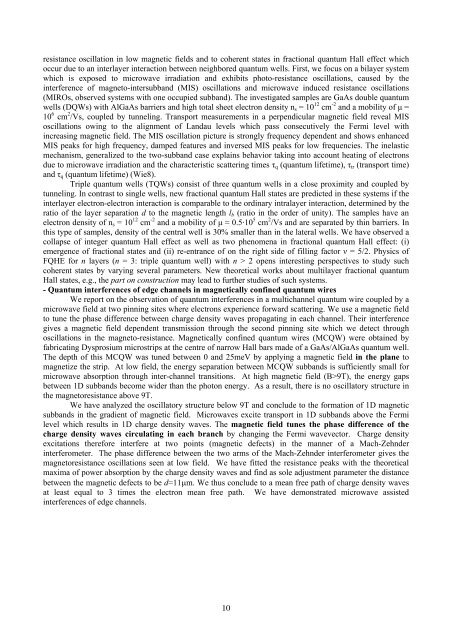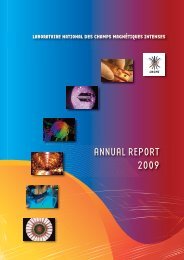Laboratoire National des Champs Magnétiques Pulsés CNRS – INSA
Laboratoire National des Champs Magnétiques Pulsés CNRS – INSA
Laboratoire National des Champs Magnétiques Pulsés CNRS – INSA
You also want an ePaper? Increase the reach of your titles
YUMPU automatically turns print PDFs into web optimized ePapers that Google loves.
esistance oscillation in low magnetic fields and to coherent states in fractional quantum Hall effect which<br />
occur due to an interlayer interaction between neighbored quantum wells. First, we focus on a bilayer system<br />
which is exposed to microwave irradiation and exhibits photo-resistance oscillations, caused by the<br />
interference of magneto-intersubband (MIS) oscillations and microwave induced resistance oscillations<br />
(MIROs, observed systems with one occupied subband). The investigated samples are GaAs double quantum<br />
wells (DQWs) with AlGaAs barriers and high total sheet electron density ns = 10 12 cm -2 and a mobility of μ =<br />
10 6 cm 2 /Vs, coupled by tunneling. Transport measurements in a perpendicular magnetic field reveal MIS<br />
oscillations owing to the alignment of Landau levels which pass consecutively the Fermi level with<br />
increasing magnetic field. The MIS oscillation picture is strongly frequency dependent and shows enhanced<br />
MIS peaks for high frequency, damped features and inversed MIS peaks for low frequencies. The inelastic<br />
mechanism, generalized to the two-subband case explains behavior taking into account heating of electrons<br />
due to microwave irradiation and the characteristic scattering times τq (quantum lifetime), τtr (transport time)<br />
and τq (quantum lifetime) (Wie8).<br />
Triple quantum wells (TQWs) consist of three quantum wells in a close proximity and coupled by<br />
tunneling. In contrast to single wells, new fractional quantum Hall states are predicted in these systems if the<br />
interlayer electron-electron interaction is comparable to the ordinary intralayer interaction, determined by the<br />
ratio of the layer separation d to the magnetic length lb (ratio in the order of unity). The samples have an<br />
electron density of ns = 10 12 cm -2 and a mobility of μ ≈ 0.5·10 5 cm 2 /Vs and are separated by thin barriers. In<br />
this type of samples, density of the central well is 30% smaller than in the lateral wells. We have observed a<br />
collapse of integer quantum Hall effect as well as two phenomena in fractional quantum Hall effect: (i)<br />
emergence of fractional states and (ii) re-entrance of on the right side of filling factor ν = 5/2. Physics of<br />
FQHE for n layers (n = 3: triple quantum well) with n > 2 opens interesting perspectives to study such<br />
coherent states by varying several parameters. New theoretical works about multilayer fractional quantum<br />
Hall states, e.g., the part on construction may lead to further studies of such systems.<br />
- Quantum interferences of edge channels in magnetically confined quantum wires<br />
We report on the observation of quantum interferences in a multichannel quantum wire coupled by a<br />
microwave field at two pinning sites where electrons experience forward scattering. We use a magnetic field<br />
to tune the phase difference between charge density waves propagating in each channel. Their interference<br />
gives a magnetic field dependent transmission through the second pinning site which we detect through<br />
oscillations in the magneto-resistance. Magnetically confined quantum wires (MCQW) were obtained by<br />
fabricating Dysprosium microstrips at the centre of narrow Hall bars made of a GaAs/AlGaAs quantum well.<br />
The depth of this MCQW was tuned between 0 and 25meV by applying a magnetic field in the plane to<br />
magnetize the strip. At low field, the energy separation between MCQW subbands is sufficiently small for<br />
microwave absorption through inter-channel transitions. At high magnetic field (B>9T), the energy gaps<br />
between 1D subbands become wider than the photon energy. As a result, there is no oscillatory structure in<br />
the magnetoresistance above 9T.<br />
We have analyzed the oscillatory structure below 9T and conclude to the formation of 1D magnetic<br />
subbands in the gradient of magnetic field. Microwaves excite transport in 1D subbands above the Fermi<br />
level which results in 1D charge density waves. The magnetic field tunes the phase difference of the<br />
charge density waves circulating in each branch by changing the Fermi wavevector. Charge density<br />
excitations therefore interfere at two points (magnetic defects) in the manner of a Mach-Zehnder<br />
interferometer. The phase difference between the two arms of the Mach-Zehnder interferometer gives the<br />
magnetoresistance oscillations seen at low field. We have fitted the resistance peaks with the theoretical<br />
maxima of power absorption by the charge density waves and find as sole adjustment parameter the distance<br />
between the magnetic defects to be d=11μm. We thus conclude to a mean free path of charge density waves<br />
at least equal to 3 times the electron mean free path. We have demonstrated microwave assisted<br />
interferences of edge channels.<br />
10







